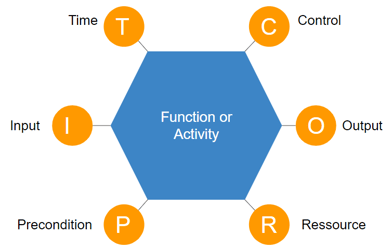
In recent years, numerous industries have undergone significant levels of complexity, including the aerospace, automotive, and energy sectors. The utilization of cutting-edge technologies, automation, and interconnected systems has led to an increased complexity of their respective systems. The generation of important data, also known as big data, has made it impossible to interconnect in real-time without the assistance of technology.
Managing risks and ensuring safety has become more challenging than ever before, leading to a growing demand for innovative risk management methods to assist organizations in understanding and managing these complex systems.
It is crucial for any organization to manage risks as it enables them to anticipate and prepare for potential threats that could jeopardize their operations and objectives. In the absence of proper risk management, organizations are vulnerable to various risks that can result in financial losses, damage to reputation, legal liabilities, or even harm to individuals or the environment. But, before delving into the management of risks in complex systems, first let’s remind us of the big trends in risk management.
History of risk management models
Over the past century, the field of risk management has undergone a significant transformation, as the understanding of accidents and how they occur has evolved.
- Sequential accident model (SAM): the early 20th century saw the emergence of the SAM, a linear approach of risks which focused on identifying and eliminating individual factors that contributed to accidents. For instance, if a worker falls off a ladder while painting, SAM would focus on improving the ladder and the worker's training to prevent future accidents.
- Epidemiological accident model (EAM): the mid-20th century saw the rise of the EAM, which focused on analyzing accidents in a broader context. EAM focused on the statistical analysis of accidents and the identification of common patterns, rather than individual events. For example, EAM could identify that many accidents occurred during a specific time of day or during specific tasks, which would inform policy changes to prevent future accidents.
- Systemic accident model (SAM): this model emerged in the 1990s, recognizing that accidents do not occur in isolation, but rather as a result of complex interactions between various elements of the system. This model acknowledges the inherent complexity of modern systems and aims to identify the systemic factors that contribute to accidents. For example, SAM could examine the various factors that led to a train derailment, such as human error, equipment failure, and communication breakdowns.
Emergence of Functional Resonance Analysis Method (FRAM)
The evolution of risk management in complex systems has spurred the emergence of novel and sophisticated methods, notably the Functional Resonance Analysis Method (FRAM), a good example of SAM. An approach to risk management that recognizes the importance of understanding how complex systems operate in practice. It is a method for modeling non-trivial socio-technical systems, not to be confused with a risk assessment method or an accident analysis method. This avant-garde approach recognizes that incidents are rarely triggered by isolated variables, but rather arise from intricate interplays and dependencies amongst diverse components of a system. As such, FRAM departs from traditional risk management models that oversimplify the multifaceted and dynamic nature of modern systems, and instead provides a comprehensive and nuanced understanding of how complex systems operate in practice.
FRAM provides a powerful tool for risk management professionals to identify and map the adaptations made by staff to ensure safety and efficiency. By analyzing the trade-offs and compromises that exist within the system and how they interact, FRAM allows organizations to make informed decisions to improve safety and resilience.
Discover the best Apps for your EHS management
How does FRAM work?
FRAM is a non-linear approach to system analysis that emphasizes understanding the functions of components rather than their structure. FRAM can help identify potential areas of risk and design safer systems and processes.
This method comprises 4 steps:
- Identifying and describing essential functions/activity required for a successful process.
- Finding out if there is variability in the functions (if the process can be done in another way)
- Determining how this variability can impact the process.
- Make recommendations for managing undesired outcomes.
While a process could be composed of various functions, in the FRAM model each function can be described by 6 aspects. These aspects include :
- Input, which refers to the items that are processed in the function,
- Output, which is the result of the function,
- Precondition, which outlines the conditions that must exist before the function starts to work,
- Resources, which are the items consumed during the process,
- Time, which sets temporal constraints on the function,
- Control, which outlines the ways that a function is monitored.
By applying the 4 steps and and considering the six aspects of each function (Figure 1), FRAM can provide a more nuanced understanding of complex systems and help identify potential areas of risk.
|
Figure 1: Function or activity with its 6 aspects |
To illustrate this, let's consider a critical process for hospital prescription management. The doctor writes a prescription for a medication, which subsequently involves other health professionals and processes, including the verification process by nursing staff before it is administered to the patient. Each function or activity in the process can be mapped using the FRAM’s hexagon, examining the activities one by one. For example, when writing the prescription, there is variability in how this is done. Sometimes the prescription is written, other times it is issued verbally by the doctor or a standing order. This is not necessarily a failure of the system but rather an adaptation made for good reasons, such as an emergency situation or a lack of personnel that could cause a delay in taking the medication, which would be detrimental to the patient. FRAM helps analysts understand these adaptations and decide whether they are legitimate and how they can be reinforced, eliminated, or standardized.
By unlocking information about these adaptations, FRAM enables staff to make trade-offs safely and positively, monitor and anticipate issues, and learn adaptive strategies for satisfactory outcomes. This approach is not only applicable to healthcare but can also be used in any industry or setting that features a socio-technical system, such as aviation, railways, or software development, etc.
Integrating FRAM into an Integrated Risk Management (IRM)
As businesses and organizations continue to navigate complex systems and ever-changing risks, there is an increasing need for innovative approaches to risk management. One such approach is Integrated Risk Management (IRM), which involves managing risks across an organization's operations and functions. In this context, the FRAM can be a valuable tool to support integrated risk management.
Using FRAM helps organizations better understand the underlying causes of accidents and failures without investing significant time to explore all possible hypotheses, but rather understand the limits of the system to develop effective strategies to better manage and limit the significant consequences associated with risks. FRAM can be applied to a wide range of systems, from manufacturing processes to healthcare systems. The application of FRAM in an integrated risk management context can offer significant benefits for organizations. By better understanding the interactions and dependencies between different elements of a system, organizations can develop more effective risk management strategies and improve overall safety and performance.
Digital solutions can provide a powerful way to apply FRAM in an integrated risk management context. For example, software platforms can help organizations to map out their systems and identify the critical dependencies between different parts of the system. By visualizing the system in this way, organizations can gain a more comprehensive understanding of the risks they face and develop targeted risk management strategies. In addition to mapping out the system, digital solutions can also help organizations to collect data on the interactions between different elements of the system. This data can be used to build models of the system that can be analyzed using FRAM.
FRAM is a method that has already gained traction in certain industries, such as healthcare and aviation. In healthcare, FRAM has been used to analyze the interactions between different elements of the system, including patients, healthcare professionals, and medical devices, in order to identify potential risks and provide recommendations for mitigating those risks. Similarly, in the aviation industry, FRAM has been used to map out aviation systems and identify critical dependencies between different parts of the system. However, the emergence of dedicated digital solutions for managing risks in these industries has made the integration of sophisticated risk management models more widespread and accessible than ever before. These digital solutions have allowed organizations to better understand complex system risks and make more informed decisions about risk mitigation strategies. As a result, the democratization of these digital solutions has led to more effective risk management practices and improved safety outcomes.
The idea of enabling safety instead of only trying to prevent accidents is an exciting one. FRAM offers a new approach that focuses on understanding work as done, not just how we assume or imagine it gets done. It identifies the adaptations and trade-offs that people make to cope with tensions and contradictions that exist within a system. As digital solutions continue to evolve and improve, FRAM can be utilized in an integrated risk management context to enhance its effectiveness and increase its application in various industries.
Need some help with your OHS management? Go further thanks to BlueKanGo and its apps
. . .




-1.jpg?width=169&name=unnamed%20(3)-1.jpg)

